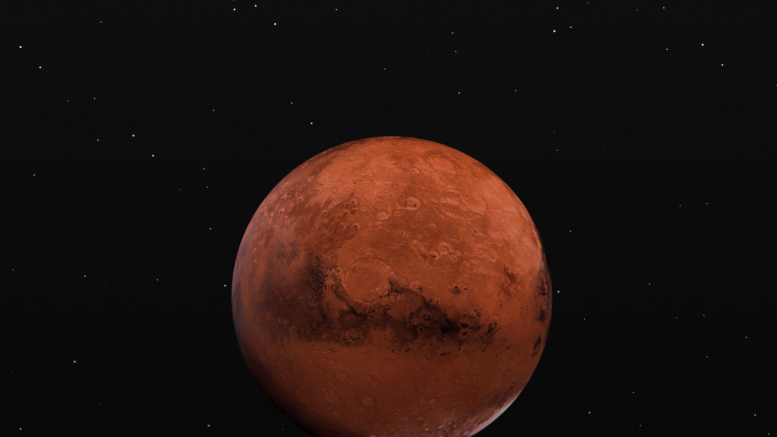Northwestern faculty and alumni are providing their expertise to get humans safely to Mars
October 8, 2021

Since humans first landed on the moon in 1969, scientists have been fixated on the next “giant leap” for space exploration— a successful human mission to Mars.
Plans for Mars missions are well underway, as NASA hopes to send astronauts in the 2030s, and SpaceX hopes to go even sooner, by 2026. Getting a spaceship to Mars is a formidable challenge, but getting a group of astronauts there safely creates a host of other problems.
As such, Northwestern researchers, students, and alumni are part of a global initiative that aims to understand and mitigate the potential hazards astronauts may face during space travel. Though they will likely never visit the red planet themselves, they are helping to pave the way for those who will.
Professor Fred Turek and Martha Hotz Vitaterna, of the Department of Neurobiology, are working to combat the harmful effects of microgravity, the feeling of weightlessness.
“Microgravity gives you a psychological high of realizing that you’re no longer confined to Earth,” said Turek, who has flown many times on NASA’s “Vomit Comet,” an airplane that gives passengers the free-floating feeling of microgravity by climbing to 35,000 feet. “You can do somersaults in the air, over and over. It’s a feeling of, ‘Wow, this is fantastic!’”
However, microgravity can wreak havoc on our made-for-Earth bodies. It causes our muscles to lose mass, our bones to lose density, and the fluids in our bodies to shift up into our heads, causing vision problems. A trip to Mars would expose astronauts to several shifts in gravity, including weightlessness on the six-plus–month voyage, then Martian gravity, which is just 38% the strength of Earth’s gravity.
Turek and Vitaterna were part of a team of researchers who studied Scott Kelly, an astronaut who stayed aboard the International Space Station for 340 days, the longest single mission for a NASA astronaut. They found that Scott’s microbiome — the trillions of bacteria and organisms that line our gut, help us digest food, and send molecules throughout our bodies — shifted during his time in space.
The change could be due to microgravity, but the results need further study. The answer could have profound implications for long-term space travel, since the microbiome can contribute to immune diseases and even mental health issues such as anxiety and depression.
“If you’re sending an astronaut to Mars, you’re sending them with millions of their little bacterial friends,” Vitaterna said. “It’s an important part of the body, and you want to use anything you can to safeguard the health and well-being of that body.”
Researchers from the McCormick School of Engineering and the School of Communication are also creating a model to determine how to best build astronaut teams that can work together in isolated environments. To do so, the researchers have interviewed astronauts who formerly lived on the ISS and studied teams within 17 different space mission analogs — where regular people live in an isolated, space-like environment for weeks or months on end.
Not only will the day-to-day aspects of living on Mars be difficult, but creating and maintaining reliable shelter is another daunting challenge. However, one McCormick professor successfully invented Marscrete, concrete made from a Martian soil simulant and sulfur, which is abundant on the planet. Marscrete is strong enough to withstand the dust storms, radiation, and meteor strikes on Mars, so the next challenge was building a structure that is human-friendly.
Turek, an expert on circadian rhythms, suggested a design that would help maintain astronauts’ sleep-wake cycles. That led the team to include hue-changing lights that shine cooler colors during the day and more reddish tones in the evening. They also included monitors that showed a video feed of the area outside — a pseudo-window to the Martian day.
Learn more in the Northwestern Magazine article “So Far Yet So Close” where they explore how Northwestern faculty and alumni are providing their expertise to get humans safely to Mars.
Science & Technology

Northwestern accelerates quantum research with NVIDIA technology
September 19, 2025
NVIDIA code could help researchers tackle computationally demanding tasks hindering quantum research Northwestern University physicists are using NVIDIA technology to tackle the computationally demanding tasks hindering quantum research. Northwestern theoretical physicist Jens Koch and his research group…

CRISPR’s efficiency triples with DNA-wrapped nanoparticles
September 18, 2025
New system delivers CRISPR machinery more safely and effectively into cells With the power to rewrite the genetic code underlying countless diseases, CRISPR holds immense promise to revolutionize medicine. But until scientists can deliver its…

Passion for the planet: A new generation of environmental stewards starts here
May 29, 2025
Over the last two decades, the Weinberg College-housed Program in Environmental Policy and Culture (EPC) at Northwestern has embraced the humanities and social sciences and cultivated a new generation of environmental stewards. Growing up in…

Northwestern receives $25 million gift to advance adolescent mental health research
May 16, 2025
New institute will study psychology of emerging adults, leading to innovative wellness programming for students at the University and beyond Northwestern University is launching the Institute for Adolescent Mental Health and Well-Being, an interdisciplinary initiative…



